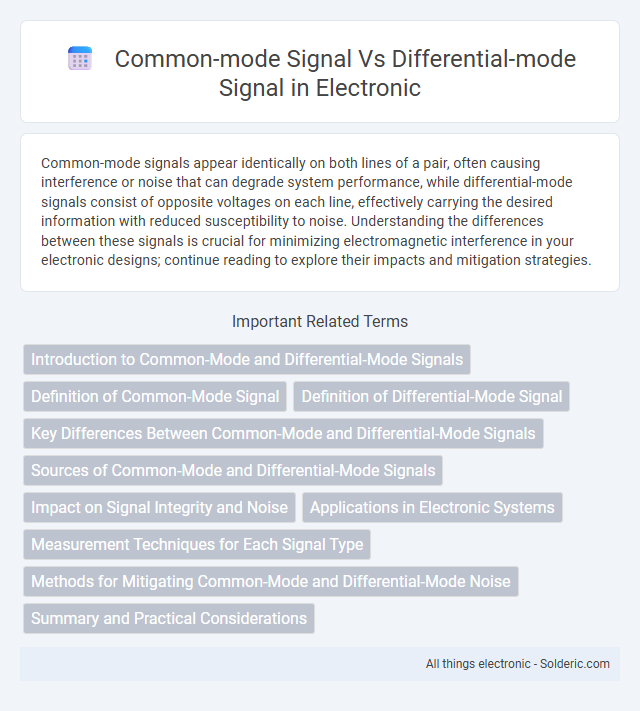Common-mode signals appear identically on both lines of a pair, often causing interference or noise that can degrade system performance, while differential-mode signals consist of opposite voltages on each line, effectively carrying the desired information with reduced susceptibility to noise. Understanding the differences between these signals is crucial for minimizing electromagnetic interference in your electronic designs; continue reading to explore their impacts and mitigation strategies.
Comparison Table
| Aspect | Common-Mode Signal | Differential-Mode Signal |
|---|---|---|
| Definition | Signal common to both lines or conductors | Signal difference between two lines or conductors |
| Signal Polarity | Same polarity on both lines | Opposite polarity on each line |
| Interference Susceptibility | High susceptibility to noise and EMI | Low susceptibility due to noise rejection |
| Signal Measurement | Measured relative to ground | Measured between the two lines |
| Application | Usually unwanted noise or interference | Used for data transmission in differential signaling |
| Examples | Electromagnetic interference (EMI) common to both wires | RS-485, USB differential data signals |
| Impact on Signal Integrity | Degrades signal quality and causes errors | Improves signal integrity and noise immunity |
Introduction to Common-Mode and Differential-Mode Signals
Common-mode signals are voltage components that appear simultaneously and in phase on two or more conductors with respect to a common reference, typically ground, often causing interference in electronic circuits. Differential-mode signals represent the voltage difference between two conductors, carrying the intended information while rejecting noise common to both lines. Understanding the distinction between common-mode and differential-mode signals is crucial for designing effective noise reduction and signal integrity solutions in your electronic systems.
Definition of Common-Mode Signal
A common-mode signal refers to the voltage component that appears identically and in-phase on both lines of a differential pair relative to a common reference point, usually ground. It is the interference or noise that affects both conductors equally, often caused by electromagnetic interference or ground potential variations. Distinguishing common-mode signals from differential-mode signals is critical in designing circuits for noise rejection and ensuring signal integrity.
Definition of Differential-Mode Signal
A differential-mode signal refers to the voltage difference between two conductors carrying equal and opposite currents, commonly used in communication and measurement systems to improve noise immunity. This signal type enhances signal integrity by rejecting common-mode noise, which appears equally on both lines. Your devices benefit from differential-mode signaling through increased accuracy and reduced electromagnetic interference.
Key Differences Between Common-Mode and Differential-Mode Signals
Common-mode signals are identical voltages present on both lines of a two-wire system relative to a common reference, typically ground, whereas differential-mode signals are equal in magnitude but opposite in polarity between the two lines. Common-mode signals often result from external interference and can cause noise in electronic systems, while differential-mode signals represent the actual transmitted data or information in differential signaling. Effective noise rejection and signal integrity in communication and measurement systems depend on distinguishing and minimizing common-mode interference while optimizing differential-mode signal fidelity.
Sources of Common-Mode and Differential-Mode Signals
Common-mode signals typically originate from external electromagnetic interference, ground loops, or noise coupling into both lines equally, resulting in unwanted voltage that can affect signal integrity. Differential-mode signals arise from intentional voltage differences between two conductors, representing the desired transmitted information or data in differential signaling systems. Understanding these sources is crucial for optimizing noise rejection and improving overall system performance in communication and electronic circuits.
Impact on Signal Integrity and Noise
Common-mode signals often degrade signal integrity by introducing noise that affects both lines equally, leading to interference and reduced accuracy in data transmission. Differential-mode signals improve noise immunity by using opposite polarity signals, allowing receivers to effectively cancel out common noise and enhance signal clarity. Maintaining a high differential-mode signal while minimizing common-mode noise is essential for robust communication systems and precise measurement accuracy.
Applications in Electronic Systems
Common-mode signals are often encountered in communication and power supply systems where noise reduction is critical, such as in twisted-pair cables and differential amplifiers designed to reject unwanted interference. Differential-mode signals dominate in data transmission interfaces like USB, Ethernet, and balanced audio lines, enhancing signal integrity by conveying information through voltage differences between two conductors. Electronic systems utilize common-mode rejection techniques in operational amplifiers and instrumentation amplifiers to improve measurement accuracy and minimize electromagnetic interference effects.
Measurement Techniques for Each Signal Type
Common-mode signals are typically measured using a differential amplifier or an oscilloscope with high common-mode rejection ratio (CMRR) to isolate noise present on both lines simultaneously. Differential-mode signals require differential probes or instrumentation amplifiers designed to capture the voltage difference between two conductors while rejecting common noise. You can ensure accurate measurement of each signal type by selecting equipment tailored for the specific mode, optimizing noise suppression and signal integrity.
Methods for Mitigating Common-Mode and Differential-Mode Noise
Effective methods for mitigating common-mode noise include the use of common-mode chokes, proper grounding techniques, and shielded cables to reduce interference. Differential-mode noise can be minimized by using twisted-pair wiring, differential amplifiers, and balanced transmission lines that reject noise on both signal lines. Your system's noise immunity improves significantly when these strategies are combined, ensuring cleaner signal transmission and enhanced overall performance.
Summary and Practical Considerations
Common-mode signals are noise voltages present equally on both lines relative to ground, while differential-mode signals represent the useful, opposing voltages between two conductors. Effective noise reduction and signal integrity in communication systems rely on maximizing differential-mode signal strength and minimizing common-mode interference. Your device's performance improves by using differential signaling techniques and proper grounding to mitigate common-mode noise impacts.
Common-mode signal vs differential-mode signal Infographic

 solderic.com
solderic.com